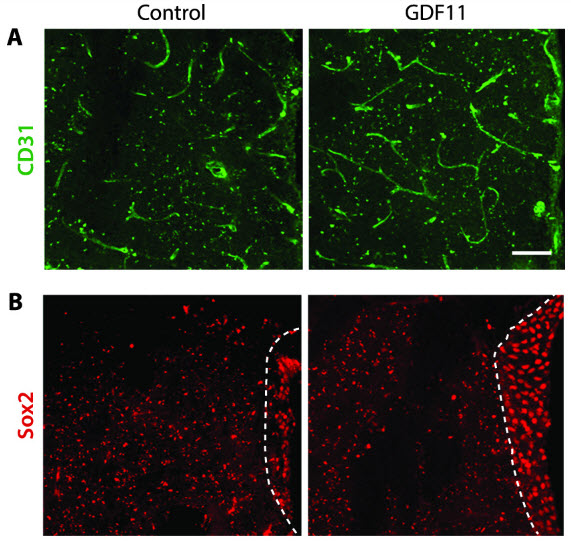Functioning of aged brains and muscles in mice made younger
May 6, 2014

Confocal images of coronal subventricular zone (SVZ) sections showing that 22-month-old mice injected with rGDF11 for 4 weeks have (A) enhanced vascularization as well as (B) increased Sox2+ neural stem cell populations, compared with those of control (credit: L. Katsimpardi et al./Science)
A protein known as GDF11 improves brain and skeletal muscle function in aging mice, Harvard Stem Cell Institute (HSCI) researchers have shown. The researchers previously demonstrated that GDF11 can make the failing hearts in aging mice appear more like those of young mice.
In two separate papers published online May 4 in the journal Science, Professors Amy Wagers, PhD, and Lee Rubin, PhD, of Harvard’s Department of Stem Cell and Regenerative Biology (HSCRB), report that injections of GDF11, which is also found in humans, improved the exercise capability of mice (equivalent in age) to the exercise capability of a 70-year-old human. The injections also improved the function of the olfactory region of the brains of the older mice — they could detect smell as younger mice do.
Rubin, and Wagers, who also has a laboratory at the Joslin Diabetes Center, each said that they expect to have GDF11 in initial human clinical trials within three to five years, baring unexpected developments.
Both studies examined the effect of GDF11 in two ways.
- By using a “parabiotic” system, in which two mice are surgically joined and the blood of the younger mouse circulates through the older mouse.
- By injecting the older mice with GDF11, which in an earlier study by Wagers and Richard Lee, MD, of Brigham and Women’s Hospital who is also an author on the two papers released today, was shown to be sufficient to reverse characteristics of aging in the heart.
Doug Melton, PhD, co-chair of HSCRB and co-director of HSCI, said he couldn’t “recall a more exciting finding to come from stem cell science and clever experiments. This should give us all hope for a healthier future. We all wonder why we were stronger and mentally more agile when young, and these two unusually exciting papers actually point to a possible answer: the higher levels of the protein GDF11 we have when young. There seems to be little question that, at least in animals, GDF11 has an amazing capacity to restore aging muscle and brain function.
Reversing cognitive decline
“We think an effect of GDF11 is the improved vascularity and blood flow, which is associated with increased neurogenesis. However, the increased blood flow should have more widespread effects on brain function. We do think that, at least in principle, there will be a way to reverse some of the cognitive decline that takes place during aging, perhaps even with a single protein. It could be that a molecule like GDF11, or GDF11 itself, could reverse the damage of aging.
“It isn’t out of question that GDF11,” or a drug developed from it, “might be capable of slowing some of the cognitive defects associated with Alzheimer’s disease, a disorder whose main risk factor is aging itself,” Rubin said. It is even possible that this could occur without directly changing the “plaque and tangle burden” that are the pathological hallmarks of Alzheimer’s. Thus, a future treatment for this disease might be a combination of a therapeutic that reduces plaques and tangles, such as an antibody directed against the β-amyloid peptide, with a potential cognition enhancer like GDF11.
Wagers said that the two research groups are in discussions with a venture capital group to obtain funding to “be able to do the additional preclinical work” necessary before moving GDF11 into human trials.
Abstract of Science paper (Manisha Sinha et al.)
Parabiosis experiments indicate that impaired regeneration in aged mice is reversible by exposure to a young circulation, suggesting that young blood contains humoral “rejuvenating” factors that can restore regenerative function. Here, we demonstrate that the circulating protein growth differentiation factor 11 (GDF11) is a rejuvenating factor for skeletal muscle. Supplementation of systemic GDF11 levels, which normally decline with age, by heterochronic parabiosis or systemic delivery of recombinant protein, reversed functional impairments and restored genomic integrity in aged muscle stem cells (satellite cells). Increased GDF11 levels in aged mice also improved muscle structural and functional features and increased strength and endurance exercise capacity. These data indicate that GDF11 systemically regulates muscle aging and may be therapeutically useful for reversing age-related skeletal muscle and stem cell dysfunction.
Abstract of Science paper (Lida Katsimpardi et al.)
In the adult central nervous system, the vasculature of the neurogenic niche regulates neural stem cell behavior by providing circulating and secreted factors. Age-related decline of neurogenesis and cognitive function is associated with reduced blood flow and decreased numbers of neural stem cells. Therefore, restoring the functionality of the niche should counteract some of the negative effects of aging. We show that factors found in young blood induce vascular remodeling, culminating in increased neurogenesis and improved olfactory discrimination in aging mice. Further, we show that GDF11 alone can improve the cerebral vasculature and enhance neurogenesis. The identification of factors that slow the age-dependent deterioration of the neurogenic niche in mice may constitute the basis for new methods of treating age-related neurodegenerative and neurovascular diseases.